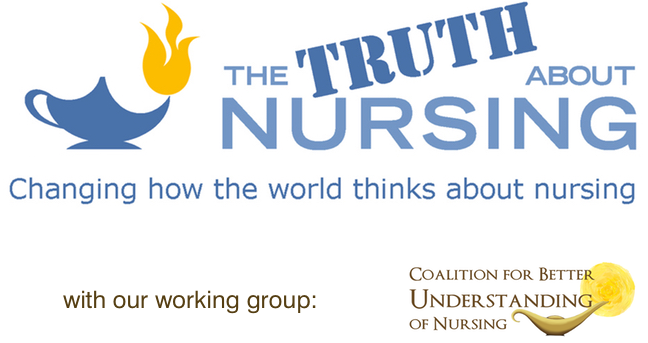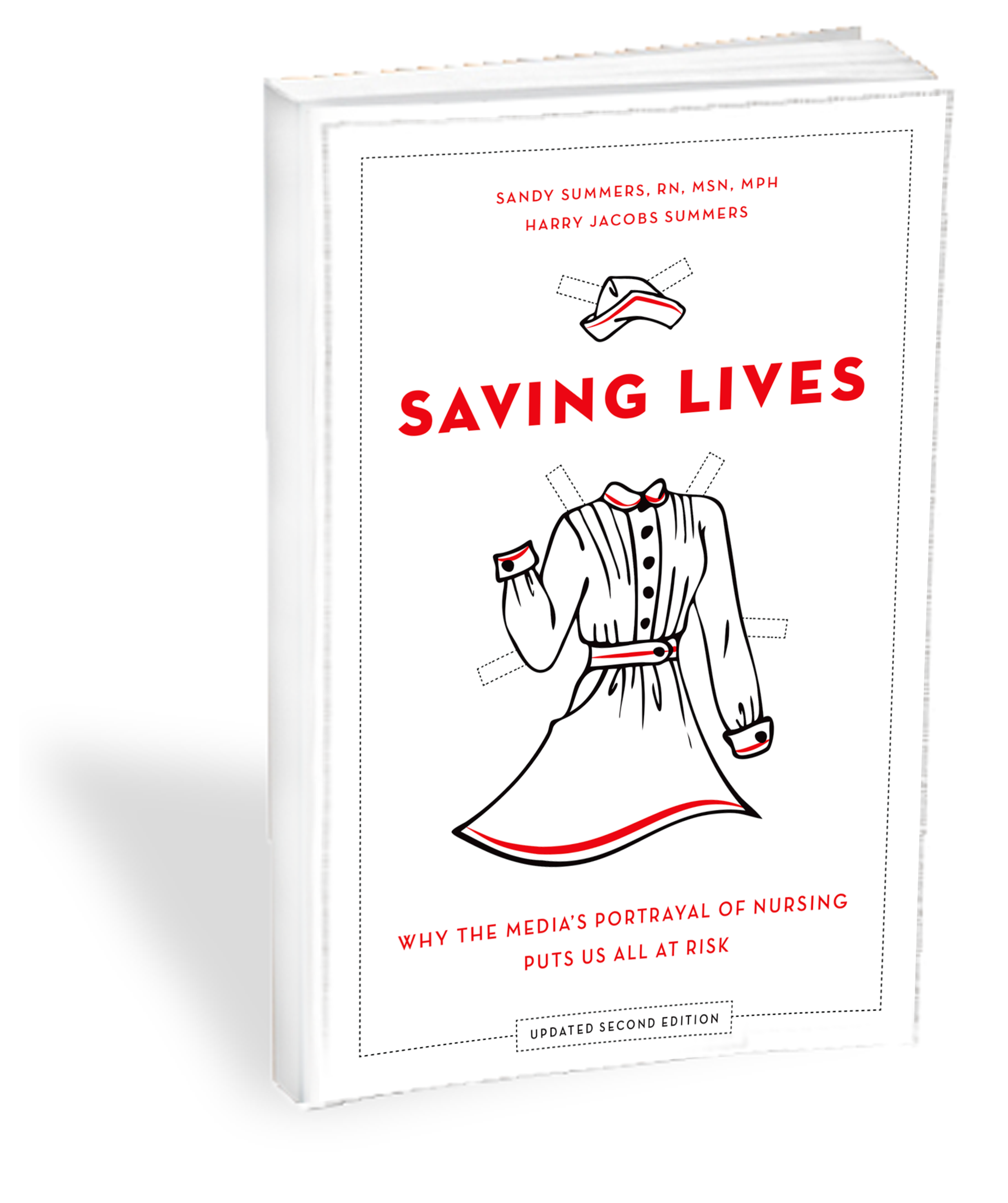Q: Come on. Even if the mass media does ignore nursing, or present it inaccurately, how can that possibly affect nursing in real life?
A: It can because what people see affects what they think, and what they think affects what they do. This isn't just an observation of how humans act. It is a basic principle of education, art, advertising, or any other organized effort to influence people. Advertising, for instance, can affect behavior when people receive persuasive, one-sided flows of information on subjects where they may not have a great deal of prior experience or knowledge. Research suggests that youngsters are especially susceptible to media influence of this kind, but no one is immune. This is why major corporations spend millions on slick advertising campaigns to promote their products, and why powerful political ads can move polling numbers and affect election results.
There is no reason to think this basic principle would not apply to health issues. Indeed, in recent years a consensus has emerged in the field of public health, based on considerable research, that what people see in the media has a significant effect on their health-related views and behavior. A wide range of public agencies, private groups and scholars now devote substantial resources to analyzing and managing health messages in the media. This is part of the public health field called "health communications."
Health communications is a "hybrid" with roots in communications, health care and other fields. (Deborah C. Glik, ScD., 2003. "Health Communication in Popular Media Formats," American Public Health Association Annual Meeting presentation, p. 1) "Communications about health in the popular media comprise both planned and unplanned content which has the potential to communicate positive, neutral or negative health messages to the public." (Id., emphasis added) The inclusion of "unplanned" content is significant. People are influenced by media content whether or not the creators specifically intended that they take away the message received, just as a parent may influence a child to act a certain way without intending to do so. A media product need not have the intent to harm nursing to have that effect.
What the media tells people about health care works much like advertising. As one public health scholar has noted, "[f]rom a social marketing perspective, messages in the media that promote specific desirable behaviors have the potential to persuade consumers to change their behavior if messages are viewed as compatible with consumers' own self-interest, competing messages are minimal, and resistance to change is low to moderate." (Id., emphasis added) And just as people influenced by commercial or political ads will also be affected by substantive health messages, people influenced by health messages will also be affected by how the media portrays the roles and conduct of health professionals. It makes little sense to think that people would learn something about cancer or AIDS from a media product, but that they would form no opinions about the health professional who is presenting the information in that product.
"Researchers have long recognized that news media coverage affects what the general public believes about health care." (Turow and Gans, "As Seen on TV: Health Policy Issues in TV's Medical Dramas," Report to the Kaiser Family Foundation, 2002, p. 1 (citing five studies dating from 1997-2002, citations omitted)) Because treatment of health topics in the news media has a significant effect on public views and actions, advocates have worked hard to affect the frequency and accuracy of the media's coverage of health topics in which they have an interest. (Glik, pp. 1-2) For example, groups promoting the professional interests of physicians have worked aggressively for decades to manage the public image of physicians and the field of medicine. The American Medical Association has devoted considerable resources to promoting coverage of medical research and other physician-centered stories in the mass media. (Buresh and Gordon, From Silence to Voice, 2001; Chocano, 2002, "Same old mish-"M*A*S*H"! Stat!". Salon; Gordon and Buresh, "Doc Hollywood", The American Prospect, 2001) These efforts have been a resounding success. (Buresh and Gordon, From Silence to Voice) Physicians, indisputably a critical part of the health care team, are now portrayed and regarded by the news media as more or less the whole team: the directors and providers of all meaningful health care. (Buresh and Gordon, From Silence to Voice; "Woodhull study on nursing and the media: Health care's invisible partner," Sigma Theta Tau International, 1997; Buresh, Gordon and Bell, "Who Counts in News Coverage of Health Care?" Nursing Outlook, 1991) Physicians are consulted on issues, such as nutrition and breastfeeding, in which other professionals generally have at least as much if not greater expertise. Physicians' combination of economic and political power with social and perceived moral status is unrivalled by any other professional group.
Many other professional, corporate and advocacy groups have also tried to influence media treatment of health issues relevant to their interests. One scholar has pointed to "the pervasive influence of certain organized or corporate interests who may use behind-the-scenes methods to unduly influence news reporting. An example reported is tactics used by the tobacco industry since the 1970's to minimize negative reports in the news media and maximize positive ones." (Glik p. 2) Why have groups made such efforts? Because "the power of the mass media to reach and influence large numbers of persons is indisputable." (Id.) Of course, by the same token, "news media credibility is often criticized." (Id.).
Thus, it is critical that anyone interested in health care, including nursing, understand how the media influences our lives. "Given the pervasiveness and potential power of the media to shape beliefs, attitudes and behaviors, the media literacy movement has emerged." (Id., p. 3) Though "media literacy" seems to be aimed primarily at helping children and teens "better deconstruct (analyze and assess) the ubiquitous media constructions" that are a key part of modern life, developing this skill is no less important for adults, especially those whose interests may not be served by prevailing media practice. Most media content, including advertising, is directed at adults. And achieving media literacy is not something that just happens on our 18th birthdays; it is not easy or automatic. It involves a process of "learning to analyze and question what is on the screen, how it is constructed, and what may have been left out." (Glik, p. 4 quoting Thoman, "Beyond Blame: Challenging Violence in the Media," Center for Media Literacy, 1995).
The bottom line is that "while there is a tremendous potential for the popular media to include positive health messages, it is a double-edge sword...From a public health perspective, one needs to view the popular media in its entirety, as both a tool for progress and a source of ill health that is a reflection of the larger culture it represents. Thus, both media advocacy and media literacy become important strategies to influence the media to improve public health and, concurrently, to mitigate its unintended effects on the most vulnerable members of society--children and teens." (Glik p. 4).
If the mass media is critical to modern health strategies, then it must also be a key means of addressing one of the most important global health problems: the crisis in nursing. The same impressionable "children and teens" whose health may be directly affected by media messages receive equally powerful messages about nursing. The result? Most students do not understand or respect nursing, and do not consider it as a career. In a study of primary and secondary school students, most respondents wrongly described nursing as a girl's job, a technical job "like shop," and an inappropriate career for private school students. (JWT Communications, Memo to Nurses for a Healthier Tomorrow on focus group studies of 1,800 school children in 10 U.S. cities, 2000)
Of course, the effects of the media's undervaluing of nursing do not stop there. When adults without significant understanding of nursing--that is, the vast majority of adults who are not nurses or very close to nurses--receive a lifetime of inaccurate, stereotypical messages about the profession, they too do not consider nursing as careers later in life. (And many nurses complain that it is difficult to garner respect even from their close family members.) Likewise, public officials and health care decision-makers with little understanding of nursing's real importance do not allocate sufficient funds to nurse staffing, nursing education, or nursing research. For instance, when hospital administrators undervalue the work of nurses, they understaff nurses, which increases patient mortality and worsens the nursing shortage. Likewise, when Congress and the Executive Branch fail to understand what nurses do to save and improve lives, they grossly underfund nursing education and research, as evidenced by the fact that only $1 out of every $200 in the NIH budget is allotted to nursing research. (National Institutes of Health, Summary of the FY2005 President's Budget) (pdf).
You might think physicians would have a better sense of nursing, and some do. However, much physician conduct seems to reflect a hierarchical, narrow and self-absorbed subculture that equates medicine with health care and is not known for questioning society's traditional assumptions. Representatives of this subculture typically see what they expect to see in nursing: not much. (We've heard physicians telling nurses that nurses receive "too much education" and that they could "train monkeys to do their jobs.") And nurses themselves are hardly immune to the effects of the media's ill treatment, which can sap their morale and professional pride, encourage cynicism and self-loathing, and discourage them from standing up for themselves and their patients. Few today doubt that pervasive media practices affect the self-image and conduct of other groups, such as women.
On the whole, the nursing crisis can be seen as the result of an entire society failing to value nursing adequately. The media is a key factor in that failure.
Also see the following related FAQ's:
Bibliography
Bernice Buresh and Suzanne Gordon. (2001). From Silence to Voice. See: www.truthaboutnursing.org/news/2001_silence_to_voice.html
Buresh, Gordon and Bell (1991). "Who Counts in News Coverage of Health Care?" Nursing Outlook, Sept./Oct., Vol. 39 No. 5 pp. 204-208.
Carina Chocano (2002). "Same old mish-"M*A*S*H"! Stat!". Salon. Available at: http://archive.salon.com/ent/tv/diary/2002/09/26/doctors/
Deborah C. Glik, ScD. (November 2003). "Health Communication in Popular Media Formats," American Public Health Association Annual Meeting presentation. Available at: http://www.medscape.com/viewarticle/466709.
Glik (above), p. 4 (quoting E. Thoman, "Beyond Blame: Challenging Violence in the Media," Teacher's Guide for Middle School Unit, Center for Media Literacy, 1995). Available at: www.medialit.org/reading_room/article93.html
Suzanne Gordon and Bernice Buresh. (2001). "Doc Hollywood." The American Prospect. Available at: http://www.prospect.org/print/V12/9/gordon-s.html
JWT Communications (2000). Memo to Nurses for a Healthier Tomorrow on focus group studies of 1,800 school children in 10 U.S. cities. Available at: http://www.truthaboutnursing.org/research/lit/jwt_memo1.html
National Institutes of Health. (February 2, 2004). Summary of the FY2005 President's Budget. Available at www.nih.gov/news/budget/FY2005presbudget.pdf (pdf).
Turow and Gans (2002). "As Seen on TV: Health Policy Issues in TV's Medical Dramas," Report to the Kaiser Family Foundation. http://www.kff.org/entmedia/3231-index.cfm
University of Southern California, the USC Annenberg School for Communication, Annenberg Norman Lear Center's Hollywood Health & Society. Available at: http://www.learcenter.org/html/projects/?cm=hhs
"Woodhull study on nursing and the media: Health care's invisible partner." (1997). Sigma Theta Tau International. Available at: www.nursingsociety.org/media/woodhullextract.html
last updated: March 25, 2005















